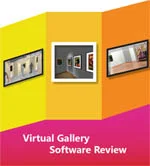If you want the public to stay up-to-date on your gallery shows and have easy access to your information, See Saw may be the app for you.
Seeing AI: An Audible Experience of the Visual World
ArtBinder Viewer: Galleries, Artists and Collectors in the Digital Age
Avant-garde art, pioneering artists, eye-opening exhibitions: you might think you can only see such things at a museum or a gallery. Guess what? You can now have the same experience at home, with ArtBinder Viewer. ArtBinder Viewer is a digital platform where you can browse artwork from some of the most reputable art galleries and artists around the globe.
Saatchi Art: Rethinking the Relationship Between Artists and Collectors
Saatchi Art is a virtual gallery for both artists and collectors. It hosts a collection of paintings, sculptures, and photographs in a variety of price ranges by artists from all over the world, providing a way for artists to exhibit and sell their work on a mobile platform.
Online Portfolio Management Tool - Works.io
Being an artist or a gallery manager in the 21st century requires an changing degree of technological know-how and engagement -- or so it might seem. In 2008, Technology in the Arts presented some options for free web sites for artists: http://www.technologyinthearts.org/2008/06/free-web-sites-for-artists/. Over the past 5 years things have only gotten easier with html5, ipads, and an ever-growing app market, and artists have more options at their fingertips to create online galleries of their very own. A slick and simple option currently in public beta-test is Works.io.
How Google Art Project Benefits the Public
How many of you have ever imagined being able to see artwork in the greatest museums around the world without leaving your chair? Driven by his passion for art, Amit Sood developed Art Project to let people do just that. The Google Art Project includes various museums from nine different countries, which provides people an access to artworks worldwide. It’s not uncommon, many people and organizations began to think about “online museums” years ago. However, I found two important features, which I rarely notice on other similar websites, that differentiate Google Art Project from others-----the extremely high pixels (10 billion) and the collection button.
image 1
(Image 1)
Some people wondering what could we get from 10 billion pixels? Google Art Project’s pursuit for an extremely high pixel count for each piece ensures audiences have a high level of exploration experience for artworks. For instance, the Harvesters, painted by Pieter Bruegel the Elder in 1565, gives you a general view on the artwork at the first glance (Image 1). Gradually, you will probably be curious about several detailed part of the paintings. What are people doing in the triangle 1 and triangle 2 areas (Image 1)? As you zoom in triangle 1 area, you will clearly see expressions on each person’s face (Image 2). Then you will really want to look deeply. As you start playing around, you will find something going on over there in triangle 2 area. As you zoom into the triangle 2 area, you will find that the artist depicted a scene of kids beating something (Image 3). Apparently, it seems to be a quite popular game. After I did a little research on Google, I found this was a game called score which involves in beating the goose with sticks. You see, I learned something from the exploration process for the painting.
image 2
(Image 2)
(Image 3)
This high standard of pixels also enables people to observe the details about brush strokes and to see how an artist actually creates the masterpiece. As I deeply go to the favorite part of the painting Starry Night painted by Van Gogh. Interestingly, as I zoomed in, the cracks noticed seemly closer the distance between Van Gogh and me. I've never gone into the Starry Night like this before.
Another amazing feature of this project is the collection button. This button enables any one of us to create our own museums online by creating our own collections out of all these images. Moreover, you can introduce your museum to your friends via sending an email and really get a conversation about what your feeling is when going to these masterpieces.
Additionally, we also see some potential values of this project for the arts education field. This could be a great tool for arts teachers to better get to the interpretations of interesting details of the masterpiece in class. For now, the Google Art Project seemingly performs well at a technical level. However, from a management perspective, some people doubt its problematic execution. Another concern is if the implication of Google Art Project is that in the future there will no longer be any need to visit a museum. This is not our focus of this post, but we are curious about your opinion about this project. Leave a comment below!
SFMOMA Families App Drives Away Gallery Fatigue
“When I’m walking around an art gallery, rooms full of paintings, after 15 or 20 minutes, I really am not thinking about the painting, I’m not connecting to them. Instead, I’m thinking about a cup of coffee that I desperately need to wake me up. I believe somebody put the painting on the wall because they think it is good enough to be there. But I don’t see it. I feel unhappy and guilt about my stupidity.” Said Tracy Chevalierin her TED speech about “Finding the story inside the painting” How many of you also suffer from gallery fatigue?
WikiLoot: A Proposal to Battle Art Smuggling with Crowdsourcing
If they do indeed exist, the Greek and Roman Gods are bound to be upset. Century after century, they have been removed from their temples in Italy and Greece to be preserved, conserved, and admired in heathen lands. Even in Egypt, the rage of the pharaohs could only be an incandescent gold. But what must really infuriate these divinities and demigods is when they are looted, smuggled, and acquired illegally.
Touring the Louvre with a Nintendo 3DS

The eagerly awaited Nintendo 3DS audio guides arrived at the Louvre in early April. For security reasons, they are not quite the action packed adventure that some may have been hoping for. Nevertheless, the audio guides are a great way to tour the museum and have some neat capabilities.
A recent review by Mike Schramm of Joystiq provides insight on just how Nintendo 3DS has been utilized at the Louvre. As he notes, the audio guide lets visitors explore the museum in three ways; an interactive map, a Masterpieces Tour, or an option called Visit a Must-See Work.
The interactive map highlights points of interest within the museum, which indicate the presence of audio commentary for a particular work. According to Schramm, “Each point of interest on the 3DS' map has at least one bit of audio commentary on it, and sometimes more than that, with various museum officials or professors talking about the work in more depth.”
The second option is the Masterpieces Tour, which will lead you to artworks that have known to draw gasps, tears, and unquestionably, l'humanité en masse. The Masterpieces Tour always keeps apace with you thanks to the 3DS has geolocation capabilities. Those with a tendency to wander will be happy to hear that the audio commentary only begins once you are within the vicinity of the masterpiece. The tour is also flexible in that you can visit other works during your tour; the 3DS will simply (and silently) wait for you to get back on track.
The final option is the Visit a Must-See Work, which will light up a “flashing route line” to a famous artwork nearby. If you happen to be lost, the option acts as a silent distress call, saving you from museological trouble one masterpiece at a time.
The Louvre’s audio guide also makes use of Nintendo’s display and 3D capabilities.“In addition to the audio commentaries, there are 3D photos of the galleries, high-definition images of the artworks, and 3D reconstructions to help you identify the exhibits and give you extra information.” Schramm mentioned how high resolution images of artworks are available on the 3DS, making it easier to explore details on the touch screen. The display is also used to showcase different artworks being compared to the artwork at hand during an audio commentary.
The only drawbacks noted by Schramm were the short battery life and the 3DS’s inability to keep up with location changes of certain pieces. Even so, the Nintendo 3DS is a Super Mario sized step forward in interactivity and audience engagement at the Louvre. In fact, the Nintendo 3DS echoes back to The O at the Museum of Old and New Art (MONA), with its geolocation and touch screen capabilities.
Devices such as The O and the 3DS do more than just guide users, they help them discover. And this sense of discovery is a lot more compelling when users are leading themselves through one of the world’s most visited museums. Nintendo in the Louvre? C’estformidable!
Now available: Virtual Gallery Software Review!
Technology in the Arts just released a publication reviewing virtual gallery software for artists and arts organizations interested in creating 3D virtual exhibitions. Access the PDF publication here. The publication reviews three online gallery systems: Virtual Gallerie, Image Armada, and Scenecaster / 3D Scene. Which one is best for your organization? Check out the publication to find out which virtual gallery software meets your needs.
This research was initiated by the CUE Art Foundation, which sought to find an existing software system that will allow artists to create and display virtual exhibitions easily.
















